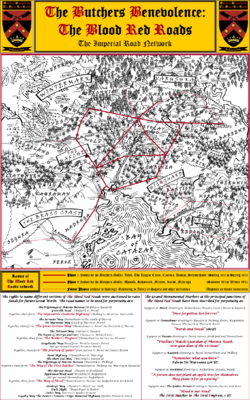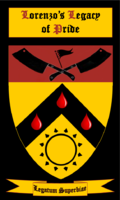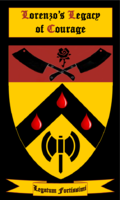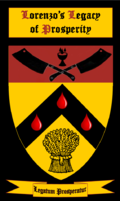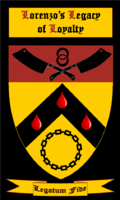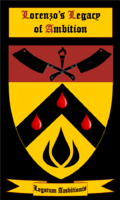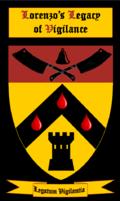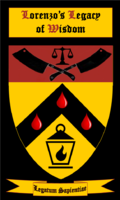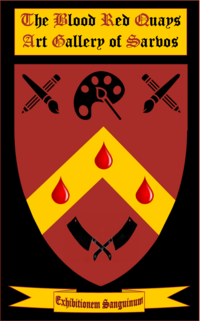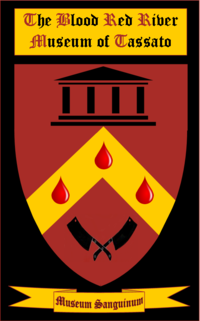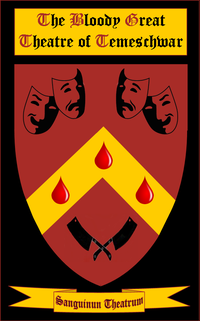Lorenzo's Legacy
Overview
The famous (and sometimes infamous) merchant prince Lorenzo “La Volpe” Macelliao von Temeschwar is the long-serving Master of the Butchers Bank, and Treasurer of the Bloody Butchers of Temeschwar. At various points, he also held the Fortress of Salt seat on the Imperial Bourse, oversaw the Regario Dossier, and served as Civilian Commissioner for the League, and was very briefly Master of the Imperial Mint.
The wealthiest citizen in the Empire's history, having made a killing in the Bourse after Britta's Death, he is considered one of the most influential citizens of the League. He is best known for Lorenzo's Legacy - a program of civic works and improvements aimed largely at increasing the prosperity of the four cities of the League. These works have put his name - and the name of his Guild - on the lips of citizens in every city in the League, wherever rich, influential, or ambitious, individuals gather together.
Great Works
La Volpe ("the fox" - a sobriquet he earned for his cunning business acumen in support of his cousin Vittorio Sabasti di Mestra) has directly or indirectly commissioned a number of great works across the Empire.
The Colossus of Sarvos
- The Colossus of Sarvos is a great work that provides additional wealth each season spread amongst those citizens of Sarvos who own businesses.
A wonder of the modern world the Colossus of Sarvos is the first sight of the City of Masks seen by ships approaching from the Bay of Catazar. The statue itself - some seventy-five feet of stone on a granite plinth twenty-five feet high - is built in the form of the First Butcher (founder of the Butchers' Bank of Temeschwar) - although some point out that the face rather more resembles that of Prince Lorenzo “La Volpe” Macelliao von Temeschwar. It is placed on a small island at the mouth of the main harbour, and maintained by a small group of dedicated stonemasons. For a brief while the the statue bore the distinctive countenance of Empress Giselle, but that enchantment faded after a year.
After the Spring Equinox 383YE, with the support of the League national assembly, Astrid Fjellrevening Rezia di Tassato consecrated the Colossus with a dose of true liao with the Partner of Greatness. This act greatly increased the influence of the Colossus. and secured its status as a wonder of the known world.
The plinth that supports the immense statue bears inscriptions commemorating the liberation of Sarvos from the Grendel in Summer 380YE. Significant space has been dedicated to honouring those who fell during the fighting to defend, and later recapture, the city.
Prior to the Spring Equinox 382YE, the colossus had a very different countenance - that of the First Butcher (founder of the Butchers' Bank of Temeschwar) - although some point out that the face rather more resembles that of Prince Lorenzo “La Volpe” Macelliao von Temeschwar. It is placed on a small island at the mouth of the main harbour, and maintained by a small group of dedicated stonemasons. Many citizens of Sarvos have been open in their appreciation of the change - even the worst critics of Empress Giselle cannot fail to acknowledge that she was a protector and guardian of the city she loved.
A few days before the Winter Solstice 381YE, a ship called the Child of Thunder rammed the Colossus, causing extensive damage. Repairs were quickly enacted, and the colossus restored to its full grandeur. In addition to the repairs, a commemorative plaque was added to the plinth commemorating those who donated their time, funds and materials to restore it. The reason for the attack is still unclear; the captain responsible was clearly not acting on his own.
The Colossus of Sarvos is a great work commissioned by the Imperial Senate in Autumn 380YE. It attracts tourists and pilgrims from all over the world, and marks Sarvos as the greatest trading port in the Empire, providing a significant boost to the economy of the City of Masks.
Blood Red Roads
- The Blood Red Roads are a great work that provides additional income to the farms and businesses of Temeschwar, Sarvos, Tassato, Holberg, Casinea, Astolat, Semmerholm, Upwold, Hahnmark, Miaren, Karov, and Madruga.
Begun shortly after the Spring Equinox of 380YE, the Blood Red Roads represent an extremely ambitious scheme on a scale not really see in the Empire since the time of Empress Aenea, the Builder. The first stage of the project linked the four League cities - Sarvos, Tassato, Temeschwar, and Holberg - with fine highways intended to bring prosperity both to the cities and to the territories through which the roads pass. The second stage linked Stockland, Holt, Kalpaheim, Delev, and Siroc to this web of roads.
It is worth noting that the Blood Red Roads are not actually red in colouration. They are wide highways (and in some cases bridges) of good quality stone. Large amounts of white granite have been used to create viaducts and bridges as needed along their length. Where the roads enter and leave the League cities, each terminus is marked by a grand gate in the shape of two crossed butcher's cleavers. These gates are inscribed with elaborate carvings and inscriptions that celebrate the seven virtues.
As the roads neared completion, numerous businesses in each nation relocated to take advantage of the swift transit routes they represented. At the same time, newly come-of-age citizens or those seeking a change in circumstance often chose to start new concerns in places the roads pass through, knowing that they will see a steady stream of customers.
It took two years to complete the program - and the project faced obstacles both internal and external. With the support of the Imperial Synod, however, the great highways were completed shortly before the Winter Solstice 381YE.
Citizens of the Brass Coast are keen to see the roads extended even further - in Autumn 381YE the Senate approved a plan to link the south-western town of Anduz in Segura to Tassato with a road partially funded by Faraden merchant families.
The Legacies of Virtue
- Each of the Legacies of Virtue is a great work that provides 37 crystal mana each season, spread amongst those League citizens of each territory who own a mana site and attended the previous summit.
Each of the six Legacies of Virtue is a great work intended to improve the production of crystal mana in one of the four League territories. Two were commissioned by Imperial Wayleave bearers - the Legacy of Pride in Sarvos, and the Legacy of Courage in Holberg. The others were commissioned by the Senate - the Legacy of Loyalty in Temeschwar, the Legacy of Ambition in Tassato, the Legacy of Prosperity in Casinea, and the Legacy of Vigilance in Hahnmark. They are intended as a gift to the Empire from "la Volpe" to inspire imperial citizens and impress visiting foreigners.
Designed with the assistance of the Wunderkind guild of Holberg, each great work is similar in scope. A number of stelae carved of red stone and surrounding cores of purified mithril, placed throughout the territory in carefully chosen locations. The stelae focus or disrupt the flows of mana, significantly improving the production of all mana sites in the area. A much larger stele is built at a single central location, serving to anchor and support the other, smaller stones. These larger structures are the key to the entire network, and if they were lost the great work would lose its effectiveness.
The designs for the Legacies of Ambition, Prosperity, and Vigilance were initially intended to be the same as those for the other two legacies, but during construction there were some significant changes implemented by Almodin Oktístis, the Asavean priest of the Builder entrusted with overseeing the construction. The Asavean architect was apparently quite enthused about this project, and spent a great deal of time poring over the designs and making alterations. In the end, he included numerous references to the false Asavean god of magic, which incensed a number of faithful League pilgrims. Following the Spring Equinox 383YE, the statues were defaced by a mob of angry citizens riled up by the Imperial Synod. The statues were smashed, and the remains used as building material for new roads in the affected territories. Fortunately, this coincided with a Senate plan to redesign the works of Almodin Oktístis. These events are covered in more detail here.
The Legacy of Pride
The central stone of the Legacy of Pride is placed in the jeweled city of Sarvos in the middle of Bertram's Square - an open air market not far from the cleaver gate that marks the terminus of the Blood red Roads. Each stele is adorned with images of suns and flags, surmounted by a pair of crossed butcher's cleavers forged of pure mithril. Inscriptions around the base emphasise the virtues of Ambition, Prosperity, and Pride.
The Legacy of Courage
The stelae of the Legacy of Courage are of a similar design to those of the Legacy of Pride, but adorned with axes and roses, and with inscriptions emphasising Pride, Loyalty, and Courage around the base. The keystone for this great work stands outside Wunderkind in the city of Holberg.
The Legacy of Prosperity
The central stone of the Legacy of Prosperity stands near Long Tom’s Brewery where the Blood Red Roads approach Anvil. Lorenzo claims that Long Tom Goodfellow, an exemplar of Prosperity, provided him with inspiration for the Butchers Benevolence and virtuous pilgrimage along the Blood Red Roads. Each of the stelae spread throughout Casinea is decorated with images of wheatsheafs and cups with three drops of red wine that represent the rewards of a prosperous job done well. Inscriptions around the base emphasise the virtues of Ambition, Wisdom and Prosperity.
The Legacy of Loyalty
The stelae of the Legacy of Loyalty are somewhat different in nature. Each consists of a squat plinth perhaps four feet high, adorned with rings. Inscriptions around the base emphasize Vigilance and Wisdom as well as Loyalty. They are topped with crossed cleavers, each set of blades surmounts a sphere of polished blue-green tempest jade carefully inscribed with a design of three drops of blood. The central stone - in this case built in the old meat-market that lies outside the Butcher's Guild offices in Temeschwar - is significantly different from those used in the previous two works. It is twelve feet tall, consisting of a four-foot plinth surmounted by an eight-foot-tall statue of a figure in traditional Temeschwari garb. In one hand the statue holds a butcher's cleaver, in the other a string of sausages. The very base of the statue is inscribed with the words “The Virtuous build up their fellows; they do not tear them down”.
The Legacy of Ambition
The stelae of the Legacy of Ambition are similar to those in Temeschwar, but adorned with torches and flames, and the inscriptions around the base emphasise the virtues of Prosperity, Pride, and Ambition. The central stone - placed in the courtyard of the Imperial Mint in Tassato - is carved in the image of two figures, back to back. Both statues point to the sky with a proudly extended index finger as if they are about to make a great speech.
The first statue, depicts Aldones di Sarvos, his gaze fixed towards Casinea. His head is haloed in mithril, studded with pieces of precisely carved lightstone that glow at all times. At his waist he has an ornately carved bottle and a telescope, highlighting his past life as Atuman the Navigator. The second statue faces the Imperial Mint, and depicts Avigliana di Sarvos, founder of that institution. In one hand she holds a weighing scale, with a cleaver on one side of the the scale, and several mithril coins in the other. Before her is a lectern, with a mithril book - the Epistemologicon - atop it, surrounded by shards of lightstone.
The Legacy of Vigilance
Spread across the entire territory of Hahnmark are a number of red stone stelae, adorned with images of towers and bells, and with their bases engraved with phrases celebrating Wisdom, Courage, and Vigilance. Each squat monolith is topped a sphere of tempest jade, marked by Ophis and framed by a pair of mithril cleavers. A central stone, the keystone for the entire great work, stands prominently in the heart of the newly built market town of New Dunhall, taking the form of a tall lithe Steinr with a plaited full beard and wild mane of hair. Upon his left shoulder sits a golden eagle, tensed and wings outstretched, as if to take flight. The figure wears a traditional tunic and leg wraps, heavy but intricate metal jewellery, a grand torc, finger and arm-rings. In his left hand he holds a long spear, planted on the ground next to two large iron balls. In his right hand he leans on a tall great axe inlaid by skilled runesmiths. The axe’s butt is clasped in an eagle’s claw. On his belt hang a small horn spoon and a large wooden tankard. He looks north over the town and slightly upwards as if gazing at the stars above the horizon. The front of the plinth reads “Dun - Blood before Water"
The Legacy of Wisdom (Ruined)
The seventh and final Lorenzo Legacy of Virtue was to have been built in Morrow. Commissioned by Edmundo of Damakhan's Forge, using an Imperial Wayleave, work began shortly after the Summer Solstice 382YE. It would have followed a similar design to the other Lorenzo Legacies, but each of the stelae was to be capped with red crystal from the Caves of the Claw. As well as their crimson mana capping, each stele was adorned with images of scales and lanterns, surmounted by a pair of crossed butcher's cleavers. Inscriptions around the base of each emphasise the virtues of Loyalty, Vigilance and Wisdom. The central stone was to have stood a short distance from the Seat of the Arbiter in Caeli.
Unfortunately, the Druj invasion of Morrow saw the site of several smaller stelae and the central stone seized by the barbarian orcs. The great work was ruined before it could be completed. In theory work could begin again, but it would require the site of the central stone to be recovered, and construction would need to begin from scratch. If the site were reclaimed before the Summer Solstice 382YE, however, the work would not require another wayleave (or Senate motion), nor another commission.
Lorenzo's Great Game
- Lorenzo's Great Game is a great work that provides additional income to business owners in Temeschwar.
The Great Game is a sprawling structure on the outskirts of Temeschwar, built at the side of the Blood Red Road. Origincally constructed in an Asavean style, this circular arcade of white granite and marble consists of an open central space where many tents, pavilions, booths, and temporary structures are established surrounded by a wide roofed colonnade containing a number of more permanent buildings and offices. In addition to gaming houses and places of refreshment, there are a number of hostelries built as part of the Great Game offering a variety of different experiences to those who wish to take lodgings near to the largest casino in Temeschwar - if not the entire northern Empire.
The original design included a number of statues and decorations referencing the false gods of the Asavean religion. Following the Spring Equinox 383YE, a mob of angry citizens riled up by the Imperial Synod descended on the Great Game. The statues and mosaics were torn out, smashed, and the remains used to resurface the nearby roads and to construct a stone privy. Fortunately, this coincided with a Senate plan to redesign the works of Almodin Oktístis. These events are covered in more detail here.
In addition to gaming houses and places of refreshment, there are a number of hostelries built as part of the Great Game offering a variety of different experiences to those who wish to take lodgings near to the largest casino in Temeschwar - if not the entire northern Empire. Several of the new buildings are named for one of Lorenzo’s other Great Works. All are lit by glowstones so bright that the marble itself seems to glow.
The most plush establishment is the Guild of Good Games' own gaming chambers called 'The Drogon' to commemorate Lorenzo La Volpe's friend Prince Drogon Morosini, former Senator of Temeschwar, who died in battle in Spring 382YE. Mysterious masked figures wearing the black and red livery of The Crimson Reapers and The Butchers Guild attentively serve their guests' every need, whether as waiters, croupiers, guards or cicisbeos.
The whole area is a love-story to Lorenzo’s history of construction. The weight of Pride that Temeschwar feels in its most prosperous resident oozes out of every edifice. In addition, statues of handsome people abound, representing those Temeschwari citizens that have made their mark on the Empire. At the entrance to the arcade stands a laughing statue of former Senators Oksana Kazaku, Gant Arachma, and Drogon Morosini in a friendly embrace. They smile at a statue of Giuseppe Sanguineo, and a space next to him invites the next senator of Temeschwar to make their mark here
The Blood Red Quays Art Gallery
- The Blood Red Quays Art Gallery is a great work that provides 15 liao and 30 votes in the Imperial Synod each season, spread amongst those citizens of Sarvos dedicated to Pride who own congregations.
The Blood Red Quays Art Gallery of Sarvos was commissioned by Magdelena Alanga di Sarvos, in the wake of a surge of interest in the arts caused by the powerful night magic enchantment that blanketed the Empire towards the end of 380YE. Paid for by the Bloody Butchers Guild of Temeschwar, it stands on the harbour front of Caricomare.
The fabulous white granite and red brick exterior is dominated by a pillared first floor balcony which provides wonderful views across the harbour to the Colossus. The interior is polished white granite, providing an impressive contrast to the red, black and gold frames of the pictures of the permanent collection. The art is displayed in a series of halls and galleries featuring portraits of prominent citizens, glorious battle scenes, and inspiring landscapes. The most magnificent of these chambers is the Butchers Gallery and features a host of portraits of illustrious members of The Butchers Guild of Temeschwar, past and present, many painted by Senator Magdelena. Another chamber is entirely devoted to the monumental markers and milestones of The Blood Red Roads - each individual milestone is inscribed to honour their sponsors, giving an impressive, if somewhat tedious, overall effect. Many visitors find the overall effect overbearing and ostentatious, however, and the gallery helps fuel accusations that the art gallery is less a paean to the pride of the League, and more a monument to the ambition of the Butchers.
One of the most popular galleries is that devoted to the artwork used by the Guild of Good Games in their popular pastimes. In this chamber citizens of Sarvos meet regularly to play and earnestly discuss many games - it is rapidly becoming a respected social salon in its own right. Other galleries, more subtly decorated with scrolling leaves and images of the rising sun, are devoted to regularly changing temporary exhibitions, many of which subsequently go on tour to the Bloody Great Theatre in Temeschwar and the Blood Red River Museum of Tassato.
The Blood Red River Museum
- The Blood Red River Museum is a great work that provides 15 liao and 30 votes in the Imperial Synod each season, spread amongst those citizens of Tassato dedicated to Pride who own congregations.
This art museum was commissioned by Cesare Sanguineo Rezia di Tassato, paid for by the Bloody Butchers Guild of Temeschwar, and taking advantage of the opportunity offered by the potent Night magic enchantment that blanketed the Empire toward the end of 380YE. Completed shortly before the Summer Solstice 381YE, it stands grandly in Tassato Mestra on the western bank of the Vassa, not far from the Printers Guild Museum of Wonders.
A magnificent structure of shining white granite and red brick, the interior is richly embellished with white and gold gilded rococo together with sumptuous red and black velvet drapes. The immense entrance hall boasts an impressive series of historical friezes celebrating modern great works, designed to inspire visitors with Pride. The first celebrates the unification of Regario and Mestra by Anabella di Regario; the second celebrates the First Feast thrown by the First Butcher for the First Empress and the leaders of the League; the third marks the foundation of the Imperial Mint by Emperor Giovanni (although the artists have played loose with history by showing him conversing with the museum's benefactor, Lorenzo 'La Volpe', who was briefly Master of the Imperial Mint); the fourth commemorates the coronation of Imperatrix Lisabetta, with a particular emphasis on Senator Cesare's part in organising the subsequent celebrations. Other displays commemorate the Blood Red Roads project, the Colossus of Sarvos, the Bloody Great Theatre of Temeschwar, the Butchers Guildhall in Temeschwar, and other structures paid for by the Bloody Butchers.
It is easy to see why some critics have dismissed the museum as being a monument to Lorenzo's ambition, rather than a place to inspire pride in League citizens! Indeed, several wags have queried why there is so much emphasis on Temeschwar in a museum intended to inspire Tassatans. Elsewhere in the museum, there are displays of historical artefacts relevant to Tassato, the League or the Empire today, but in some ways their display appears to be more of an afterthought than the purpose for which this gaudy museum was constructed.
The museum was rebuilt and expanded after an arson attack by a small family of Faraden. While the museum was rebuilt along similar lines where possible, the new wing includes an exhibition curated by Astrid Fjellrevening Rezia di Tassato on the history of true liao. It features items of historical significance discovered after past life visions, information on the origins of liao, and a small section telling the story of Lord Colwyn de Rondell's past life vision which led to the vandalism of the original museum.
The Bloody Great Theatre
- The Bloody Great Theatre is a great work that provides a pool of 30 votes in the Imperial Synod and 15 additional liao spread among the congregations of Temeschwar which are overseen by League priests belonging to the Assembly of Pride.
The Bloody Great Theatre was commissioned by Gant Archama and approved by the Imperial Senate in Winter 380YE, in the wake of a powerful surge of interest in the arts. A small movement to have the building officially named "Grand Temeschwari Theatre" gained very little traction - the amusement of calling such a large and impressive structure by such a common name has meant it has largely stuck.
Paid for primarily by the Bloody Butchers of Temeschwar, It stands along the western banks of the Gancio, near the centre of the city proper, on the site of an old, dilapidated barracks decommissioned during the reign of Empress Giselle. The structures were purchased and demolished, and a bright new building of white granite and red brick built in its place.. The building has been described as "a blocky eyesore" by visiting Sarvosan critics, but it is seen by the locals as a fine and sturdy example of the best kind of Temeschwari architecture "any building that cannot survive a direct hit from a trebuchet might as well be made of wattle and daub" as one wag puts it.
The theatre has a truly grand stage, with an auditorium that can seat several hundred people comfortably as well as an open floor for several hundred more standing audience members. Behind the scenes, engineers from Holberg were engaged at no small expense to arrange the finest backstage mechanisms that money can buy, and worked with local architects to ensure that the stage has the finest possible acoustic qualities. It has revitalised Temeschwar's drama (and indeed dramaturgic) communities, and there is a great deal of competition to perform in the new building. In addition to its purpose as a center for drama and music, the custodians of the Bloody Great Theatre commission works of sculpture and paining to adorn the walls, and are very interested in acquiring relics connected to key figures from Temeschwar's past. As such, it is fast becoming a place of pilgrimage for citizens interested in exploring the history of the northernmost League city.
He looked around the assembled luminaries of the Butchers Guild, gathered beneath the magnificent portraits in their opulent Guildhall. His eyes settled on Adelada von Temeschwar, Bourseholder of the Golden Trees of Seren, the youngest ever bourseholder in the history of the Empire. "You decide" he said as he solemnly offered her the Ceremonial Cleaver of The First Butcher.
Adelada looked left at Dyta von Temeschwar, Bourseholder of The Hunt of Alderei the Fair, the proprietor of the Bloody Theatre in Temeschwar. Then she looked right at Falko the famous playwright, Bourseholder of The Singing Caves. She recalled their pride when Falko's famous plays performed to packed houses every night in the Bloody Theatre. She seized the Cleaver, hammered it on the table and declared: "A theatre. A new theatre. A bigger, better, grander theatre. A Bloody Great Theatre!"

